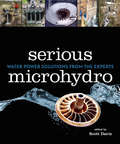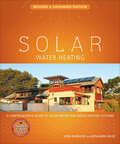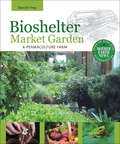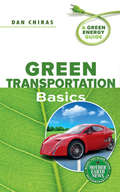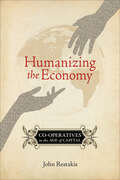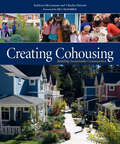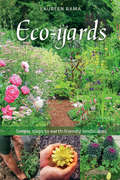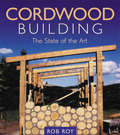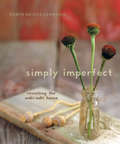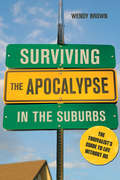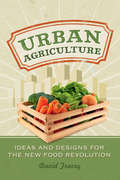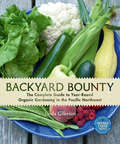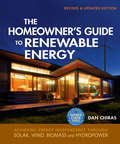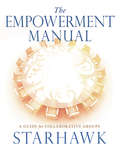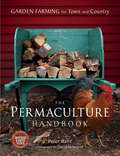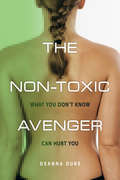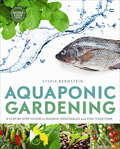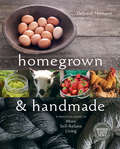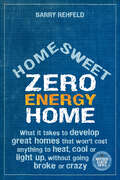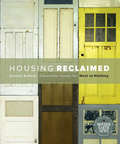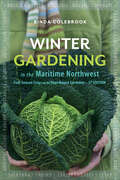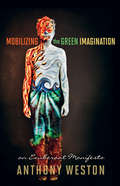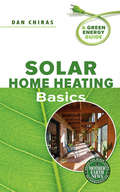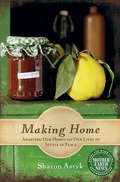- Table View
- List View
Serious Microhydro
by Scott DavisWaterpower is the largest source of renewable energy in the world today, and microhydro is a mature, proven technology that can provide clean, inexpensive, renewable energy with little or no impact on the environment. Serious Microhydro brings you dozens of firsthand stories of energy independence covering a complete range of systems, from household pressure sites to higher pressure installations capable of powering a farm, business, or small neighborhood. Topics include: Low head and medium head sites AC-only systems as well as ones using a battery/inverter subsystem Stand alone power supply or grid intertie setups Hybrid systems (combined with photovoltaics or wind) With all the variables involved in microhydro, there is no "typical" system. These case studies represent the most comprehensive collection of knowledge and experience available for tailoring an installation to meet the needs of a site and its owner or operators. If you are considering building a system, you are bound to find a wealth of creative solutions appropriate to your own circumstances. Serious Microhydro shows how scores of people are achieving a high standard of living from local energy sources with a minimal ecological footprint. It has particular appeal to homeowners, teachers, renewable energy professionals, activists, and decision makers who want to understand the technology from a "hands-on" perspective. Scott Davis is an award-winning renewable energy project developer with decades of experience operating, installing, designing, selling, and teaching microhydro technology. He is a founder and president of Friends of Renewable Energy BC, and the author of Microhydro: Clean Power From Water.
Solar Water Heating: A Comprehensive Guide to Solar Water and Space Heating Systems (Mother Earth News Books for Wiser Living)
by Bob Ramlow Benjamin NuszHeating water with the sun is a practice almost as old as humankind itself. Solar Water Heating , now completely revised and expanded, is the definitive guide to this clean and cost-effective technology. Beginning with a review of the history of solar water and space heating systems from prehistory to the present, Solar Water Heating presents an introduction to modern solar energy systems, energy conservation and energy economics. Drawing on the authors' experiences as designers and installers of these systems, the book goes on to cover:Types of solar collectors, solar water and space heating systems and solar pool heating systems, including their advantages and disadvantagesSystem components, their installation, operation, and maintenanceSystem sizing and sitingChoosing the appropriate system.This book focuses on the financial aspects of solar water or space heating systems, clearly showing that such systems generate significant savings in the long run. With many diagrams and illustrations to complement the clearly-written text, this book is designed for a wide readership ranging from the curious homeowner to the serious student or professional.
Bioshelter Market Garden: A Permaculture Farm (Mother Earth News Books for Wiser Living)
by Darrell Frey&“This well-illustrated case study . . . will help students of permaculture, of sustainability, of earth regeneration and of integrated eco-social design.&” —Prof. Declan Kennedy, Chairman, Advisory Board, gaiauniversity.org To ensure food security and restore the health of the planet, we need to move beyond industrial agriculture and return to the practice of small-scale, local farming. The Bioshelter Market Garden: A Permaculture Farm describes the creation of a sustainable food system through a detailed case study of the successful year-round organic market garden and permaculture design at Pennsylvania&’s Three Sisters Farm. At the heart of Three Sisters is its bioshelter—a solar greenhouse which integrates growing facilities, poultry housing, a potting room, storage, kitchen facilities, compost bins, a reference library and classroom area. The Bioshelter Market Garden examines how the bioshelter promotes greater biodiversity and is an energy efficient method of extending crop production through Pennsylvania&’s cold winter months. Both visionary and practical, this fully illustrated book contains a wealth of information on the application of permaculture principles. Some of the topics covered include: Design and management of an intensive market garden farmEnergy systems and bio-thermal resourcesEcological soil management and pest controlWetlands usageSolar greenhouse design and management Whatever your gardening experience and ambitions, this comprehensive manual is sure to inform and inspire.&“Darrell Frey&’s inspirational book gives you all you need to know to create an energy-saving, food-producing bioshelter . . . [It] covers everything you need to understand, build, or simply admire these important tools for sustainability.&” —Toby Hemenway, author of Gaia&’s Garden
Green Transportation Basics
by Dan ChirasOur automobile culture is devastating for the environment, but private passenger vehicles are unlikely to disappear from our roads anytime soon. Greener cars and fuels will be a necessity for many years to come.Green Transportation Basics is a guide to greening your personal driving habits by dramatically improving the efficiency of an existing vehicle using simple measures such as trip planning and regular maintenance to improve fuel economy. This handy guide also explores the most promising new green cars and trucks, including electric vehicles, hybrids, plug-in hybrids, and natural-gas cars. And it critically examines sustainable fuels including ethanol, biodiesel, straight vegetable oil, hydrogen, and biomethane, evaluating each according to a set of established criteria. Each green fuel source must:Be socially, economically, and environmentally sustainableHave a high net energy yieldBe clean, abundant, renewable, and affordableDon't let your dream of greening your transportation idle-Green Transportation Basics will guide you through the myths and misconceptions and provide clear options for the road to a more sustainable future.Dan Chiras is a respected educator and author who has published nearly thirty books on renewable energy and sustainable living, including Power from the Sun and Power from the Wind. He is the director of the Evergreen Institute, where he teaches workshops on green transportation, including green fuels and vehicles and electric car conversion.
Humanizing the Economy: Co-operatives in the Age of Capital
by John RestakisHow the largest social movement in history is making the world a better place.At the close of the twentieth century, corporate capitalism extended its reach over the globe. While its defenders argue that globalization is the only way forward for modern, democratic societies, the spread of this system is failing to meet even the most basic needs of billions of individuals around the world. Moreover, the entrenchment of this free market system is undermining the foundations of healthy societies, caring communities, and personal wellbeing.Humanizing the Economy shows how co-operative models for economic and social development can create a more equitable, just, and humane future. With over 800 million members in 85 countries and a long history linking economic to social values, the co-operative movement is the most powerful grassroots movement in the world. Its future as an alternative to corporate capitalism is explored through a wide range of real-world examples including:Emilia Romagna's co-operative economy of in Northern ItalyArgentina's recovered factory movementJapan's consumer and health co-operativesHighlighting the hopes and struggles of everyday people seeking to make their world a better place, Humanizing the Economy is essential reading for anyone who cares about the reform of economics, globalization, and social justice.John Restakis has been active in the co-op movement for 15 years. He is the Executive Director of the BC Co-operative Association and has been a consultant for co-op development projects in Africa and Asia. A pioneering researcher on co-operative economies, he writes and lectures on economic democracy and the role of co-operatives in humanizing economies.
Creating Cohousing
by Kathryn Mccamant Charles DurrettCohousing balances privacy and independence with the benefits of living in community. This completely revised and updated third edition of the "cohousing bible" invites readers into these sustainable neighborhoods, and provides practical tools for developing their own.
Eco-yards: Simple Steps to Earth-Friendly Landscapes
by Laureen Rama&“A gentle, practical and inspiring guide to help you transform your yard into a diverse, healthy and sustainable landscape.&”—Myrna Pearman, coauthor of NatureScape Alberta Many urban yards are essentially unproductive patches of grass, requiring constant attention for no return. Through sustainable, organic landscaping, these small or large plots of land can become part of the solution to today&’s environmental challenges.Eco-yards supports the vision of a healthy, abundant planet in which beautiful, richly varied urban yards contribute to restoring the natural ecosystem. This inspiring and practical, well-illustrated manual includes clear, easy-to-follow instructions for: Designing and maintaining an eco-yardMaking your yard water-wiseUnderstanding basic soil scienceReplacing your lawn with tree, shrub and flower beds or hardy, low-maintenance grassGrowing vegetables in the eco-yard Visionary, hopeful and encouraging, Eco-yards is a must-read for anyone who wants to use environmentally sound practices when they garden, whether in a residential yard or on the balcony of a condo or high-rise apartment. If you&’re sick of the backyard battle, this book will show you how to work with nature instead of fighting it, using simple steps that apply practically anywhere to turn your yard into an eco-friendly sanctuary. &“A rich compost of the practical and scientific . . . this is a book for every gardener concerned for the health of the environment.&”—Roberta Rees, author of Long After Fathers &“Rama is a hands-on gardener who explains—in great detail—everything from building soil to creating sustainable landscapes. Read about it here and then get out and practice what Rama preaches.&”—Donna Balzer, BScA, horticulturist and co-host of the internationally broadcast television show Bugs & Blooms
Cordwood Building
by Rob RoyCordwood masonry is an ancient building technique whereby walls are constructed from "log ends" laid transversely in the wall. It is easy, economical, aesthetically striking, energy-efficient, and environmentally sound.Cordwood Building collects the wisdom of more than 25 of the world's best practitioners, detailing the long history of the method, and demonstrating how to build a cordwood home using the latest and most up-to-date techniques, with a special focus on building code issues.Author/editor Rob Roy has been building, researching, and teaching about cordwood masonry for 25 years and, with his wife, started Earthwood Building School in 1981. He has written 10 books on alternative building, presented four videos--including two about cordwood masonry--and has taught cordwood masonry all over the world.
Simply Imperfect: Revisiting the Wabi-Sabi House
by Robyn Griggs LawrenceThis revised and updated edition of The Wabi-Sabi House recounts the history of this aesthetic philosophy and reveals ways to introduce it into your home. The ancient Japanese philosophy of wabi-sabi is about appreciating simplicity and letting go of the superficial—the perfect antidote to modern consumerism and perfectionism. In 2004, author Robyn Griggs Lawrence helped popularize wabi-sabi in North America with her book The Wabi-Sabi House. In Simply Imperfect, Lawrence shows that wabi-sabi is far more than a style of home décor. It&’s a state of mind—a way of living modestly in the moment, stripping away the unnecessary, and finding satisfaction in everyday things. Tracing the rich history of wabi-sabi from its Zen Buddhist roots to the present day, this beautifully-illustrated book also offers tips on: Clearing clutter and blocking noiseIntegrating salvaged and recycled materialsMaking and growing things yourself (or supporting local artisans who do)Taking time and space for self-reflection
Surviving the Apocalypse in the Suburbs
by Wendy BrownBased on the premise that we have 21 days before we lose our modern conveniences, Surviving the Apocalypse in the Suburbs is packed with practical solutions for becoming more self-reliant and transitioning to a lower energy lifestyle. From shelter to livestock to transportation to tools, this is the ultimate guide to simplifying your lifestyle while reducing your dependence on oil.
Urban Agriculture
by David TraceyUrban Agriculture is packed with ideas and designs for anyone interested in joining the new food revolution. First-time farmers and green thumbs alike will find advice on growing healthy, delicious, affordable food in urban settings. From condo balconies to community orchards, cities are coming alive with crops. Get growing!
Backyard Bounty
by Linda GilkesonThis practical guide is packed with simple, low-maintenance methods to produce the most organically grown food all year round from any home garden. With advice on soil preparation, composting, seeding, watering, mulching, pruning, winter crop planting schedules, greenhouses and more, as well as a wealth of information specific to the West Coast climate, Backyard Bounty will get you growing.
Creating Wealth
by Bernard Lietaer Gwendolyn HallsmithLocal currencies have been introduced in thousands of communities around the world in response to the economic crisis because they offer an alternative to money as a way of meeting important human needs. Community leaders can mobilize assets using complementary currencies to address social and economic issues including health care, education, elder care, environmental problems, housing, and food security.
The Homeowner's Guide to Renewable Energy: Achieving Energy Independence through Solar, Wind, Biomass and Hydropower (Mother Earth News Books for Wiser Living)
by Dan ChirasFrom the author of Power from the Sun, the complete guide to switching to clean, affordable, renewable energy resources. Energy bills have skyrocketed in the United States, and traditional energy sources can be as damaging to the environment as they are to your pocketbook. The Homeowner&’s Guide to Renewable Energy will show you how to slash your home energy costs while dramatically reducing your carbon footprint. Completely revised and updated, this new edition describes the most practical and affordable methods for significantly improving in-home energy efficiency and tapping into clean, affordable, renewable energy resources. If implemented, these measures will save the average homeowner tens of thousands of dollars over the coming decades. Focusing on the latest technological advances in residential renewable energy, this guide examines each alternative energy option available including:· Solar hot water and solar hot air systems · Passive and active solar retrofits for heating and cooling · Electricity from solar, wind, and microhydro · Hydrogen, fuel cells, methane digesters, and biodiesel This well-illustrated and accessible guide is an essential resource for those wanting to enter the renewable energy field. Packed with practical tips and guidelines, it gives readers sufficient knowledge to hire and communicate effectively with contractors and is a must-read for anyone interested in saving money and achieving energy independence.&“If you&’re thinking about investing in a renewable energy system for your home . . . The Homeowner&’s Guide to Renewable Resources helps clarify the decision-making process . . . . Dan guides you through everything you need to choose which renewable options to integrate into your lifestyle. A great addition to my bookshelf!&” —Mick Sagrillo, Sagrillo Power & Light
The Empowerment Manual
by StarhawkA Transition Town group involved in preparations for peak oil and climate change; an intentional community, founded with the highest ideals; a nonprofit dedicated to social change-millions of such voluntary groups exist around the world. These collaborative organizations have the unique potential to harness their members' ideals, passions, skills, and knowledge-if they can succeed in getting along together.The Empowerment Manual is a comprehensive manual for groups seeking to organize with shared power and bottom-up leadership to foster vision, trust, accountability, and responsibility. This desperately needed toolkit provides keys to:*Understanding group dynamics*Facilitating communication and collective decision-making*Dealing effectively with difficult people.Drawing on four decades of experience, Starhawk shows how collaborative groups can generate the cooperation, efficacy, and commitment critical to success. Her extensive exploration of group process is woven together with the story of RootBound-a fictional ecovillage mired in conflict-and rounded out with a series of real-life case studies. The included exercises and facilitator toolbox show how to establish the necessary structures, ground rules, and healthy norms. The Empowerment Manual is required reading for anyone who wants to help their group avoid disagreement and disillusionment and become a wellspring of creativity and innovation.Starhawk is the author of eleven previous books including the award-winning Webs of Power. A highly influential voice for global justice and the environment, she is deeply committed to bringing the creative power of spirituality to political activism.
The Permaculture Handbook
by David Holmgren Peter BaneThe urban landscape has swallowed vast swaths of prime farmland across North America. Imagine how much more self-reliant our communities would be if thirty million acres of lawns were made productive again. Permaculture is a practical way to apply ecological design principles to food, housing, and energy systems, making growing fruits, vegetables, and livestock easier and more sustainable.The Permaculture Handbook is a step-by-step, beautifully illustrated guide to creating resilient and prosperous households and neighborhoods, complemented by extensive case studies of three successful farmsteads and market gardens. This comprehensive manual casts garden farming as both an economic opportunity and a strategy for living well with less money. It shows how, by mimicking the intelligence of nature and applying appropriate technologies such as solar and environmental design, permaculture can:*Create an abundance of fresh, nourishing local produce *Reduce dependence on expensive, polluting fossil fuels*Drought-proof our cities and countryside*Convert waste into wealthPermaculture is about working with the earth and with each other to repair the damage of industrial overreach and to enrich the living world that sustains us. The Permaculture Handbook is the definitive practical North American guide to this revolutionary practice, and is a must-read for anyone concerned about creating food security, resilience, and a legacy of abundance rather than depletion.Peter Bane is a permaculture teacher and site designer who has published and edited Permaculture Activist magazine for over twenty years. He helped create Earthaven Ecovillage in North Carolina, and is now pioneering suburban farming in Bloomington, Indiana.
The Non-Toxic Avenger
by Deanna DukeMost of us turn a blind eye to the startling array of chemicals lurking in everything from shampoo to baby bottles to the money in our wallets, choosing to believe that government agencies ensure the safety of the products we wear, use, ingest, and breathe in daily. Yet the standards for product safety in North America lag far behind those of other countries. We frequently hear that a substance we've relied on for years turns out to have serious effects on our health, the environment, or both. After coming to terms with the fact that the autism and cancer which had impacted her family were most likely the result of environmental toxins, author Deanna Duke undertook a mission to dramatically reduce her family's chemical exposure. She committed to drastically reducing the levels of all known chemicals in both her home and work environments, using the help of body burden testing to see what effect, if any, she was able to have on the level of toxins in her body. Follow Deanna's journey as she uncovers how insidious and invasive environmental toxins are. Learn about your day-to-day chemical exposure, the implications for your health, and what you can do about it. And find out whether the author's quest is mission impossible, or whether she is ultimately able to improve her family's health by taking steps towards leading a chemical-free life. Deanna L. Duke is an environmental writer, urban homesteader, and author of the highly acclaimed environmental blog The Crunchy Chicken.
Aquaponic Gardening: A Step-by-Step Guide to Raising Vegetables and Fish Together (Mother Earth News Books for Wiser Living)
by Sylvia Bernstein&“I have always wanted to figure out how to do sustainable aquaculture in the context of my home garden. Finally I&’ve got the book to help me do it.&” —Paul Greenberg, New York Times–bestselling author, Four Fish: The Future of the Last Wild Food Aquaponics is a revolutionary system for growing plants by fertilizing them with the waste water from fish in a sustainable closed system. A combination of the best of aquaculture and hydroponics, aquaponic gardening is an amazingly productive way to grow organic vegetables, greens, herbs and fruits, while providing the added benefits of fresh fish as a safe, healthy source of protein. On a larger scale, it is a key solution to mitigating food insecurity, climate change, groundwater pollution and the impacts of overfishing on our oceans.Aquaponic Gardening is the definitive do-it-yourself home manual, focused on giving you all the tools you need to create your own aquaponic system and enjoy healthy, safe, fresh and delicious food all year round. Starting with an overview of the theory, benefits and potential of aquaponics, the book goes on to explain: System location considerations and hardware components The living elements—fish, plants, bacteria, and worms Putting it all together—starting and maintaining a healthy system. Aquaponics systems are completely organic. They are four to six times more productive and use 90 percent less water than conventional gardens. Other advantages include no weeds, fewer pests, and no watering, fertilizing, bending, digging, or heavy lifting—in fact, there really is no down side! Anyone interested in taking the next step towards self-sufficiency will be fascinated by this practical, accessible and well-illustrated guide. &“An excellent primer for anyone considering home-scale aquaculture.&” —Peter Bane, publisher, Permaculture Activist and author, The Permaculture Handbook
Homegrown and Handmade
by Deborah NiemannOur food system is dominated by industrial agriculture and has become economically and environmentally unsustainable. The incidence of diet-related diseases, including obesity, diabetes, hypertension, cancer, and heart disease, has skyrocketed to unprecedented levels. Whether you have forty acres and a mule or a condo with a balcony, you can do more than you think to safeguard your health, your money, and the planet.Homegrown and Handmade shows how making things from scratch and growing at least some of your own food can help you eliminate artificial ingredients from your diet, reduce your carbon footprint, and create a more authentic life. Whether your goal is increasing your self-reliance or becoming a full-fledged homesteader, it's packed with answers and solutions to help you:*Take control of your food supply from seed to plate*Raise small and medium livestock for fun, food, and fiber*Rediscover traditional skills to meet more of your family's needs than you ever thought possibleThis comprehensive guide to food and fiber from scratch proves that attitude and knowledge is more important than acreage. Written from the perspective of a successful self-taught modern homesteader, this well illustrated, practical, and accessible manual will appeal to anyone who dreams of a simpler life.Deborah Niemann is a homesteader, writer, and self-sufficiency expert who presents extensively on topics including soapmaking, bread baking, cheesemaking, composting, and homeschooling. She and her family raise sheep, pigs, cattle, goats, chickens, and turkeys for meat, eggs, and dairy products, while an organic garden and orchard provides fruit and vegetables.
Home Sweet Zero Energy Home (Mother Earth News Books for Wiser Living)
by Barry RehfeldZero energy homes produce at least as much energy as they consume through a combination of energy efficiencies, passive design and renewable energy production. California has adopted zero net energy as the new residential standard for 2020; many other governments are considering similar policies. Developing zero energy homes is the first step towards making all buildings zero energy — a critical step in mitigating climate change, since buildings account for 40% of material and energy use worldwide.Home Sweet Zero Energy Home is the first practical guidebook that clearly shows how zero energy homes can be good, livable, affordable homes. The author identifies all the pieces of the zero energy puzzle and how they fallinto place, and explains how homeowners and buyers can also take smaller steps towards sharply reducing the energy use of existing buildings. Focusing on real costs and savings, this book takes an in depth look at:Site selection and passive designInsulation, windows, doors and building materialsHeating and coolingAppliances and electronicsFinancial resources and incentives.Whether you are a prospective buyer, owner, or developer, Home Sweet Zero Energy Home is your complete guide to creating a more comfortable, efficient, environmentally friendly home without breaking your back or yourbank account.
Housing Reclaimed
by Jessica KellnerHousing is a fundamental human right. For most of human history, our homes were built by hand from whatever local materials were available. However, since the Industrial Revolution, most housing has become little more than quickly constructed, mass-produced, uniform boxes. At the same time, the invention and standardization of the thirty-year mortgage and our ever-increasing reliance on credit has come to mean that most of us never own our homes outright.Housing Reclaimed is a call to arms for nonconventional home builders. It examines how technological advances, design evolution, and resourceful, out-of-the-box thinking about materials and efficiency can help us meet the challenge of building affordable, environmentally friendly, beautiful, and unique homes. Focusing on the use of salvaged and reclaimed materials, this inspirational volume is packed with case studies of innovative projects including:*Phoenix Commotion-working together towards low-income home ownership through sweat equity and 100 percent recycled materials*HabeRae-revitalizing neighborhoods by creating urban infill using modern technology and sustainable and reclaimed materials*Builders of Hope-rescuing and rehabilitating whole houses slated for demolitionThese projects and others like them demonstrate that building one's own home does not have to be an unattainable dream. This beautifully illustrated guide is a must-read for anyone interested in creating quality zero- or low-debt housing, reducing landfill waste, and creating stronger communities.Jessica Kellner is the editor of Natural Home and Garden magazine and a passionate advocate of using architectural salvage to create aesthetically beautiful, low-cost housing.
Winter Gardening in the Maritime Northwest: Cool-Season Crops for the Year-Round Gardener
by Binda ColebrookMany gardeners can supply a significant amount of their own food during the plentiful summer harvest. But the key to substantial savings on your food bill is putting fresh, homegrown produce on your table every month of the year. And in the mild, forgiving climate of the maritime Pacific Northwest, it can be easier than you might think.In Winter Gardening in the Maritime Northwest, Binda Colebrook provides a complete guide to cool-season crops and how to raise them. Gardeners from Southeastern Alaska to southern Oregon will benefit from her clear, practical advice on:Selecting and preparing the ideal winter gardening siteMaximizing production and minimizing pests with cloches, cold frames, mulches and companion plantingChoosing the best strains and hardiest varieties for a year-round growing season.An excellent companion volume to The Winter Harvest Cookbook, this revised and updated edition of the classic text will have you serving up fabulous alternatives to bland, expensive and tasteless imported supermarket vegetables in no time. Whether your favorite meals include hearty roots or succulent greens, Winter Gardening in the Maritime Northwest will help you maximize your food production year-round.
Mobilizing the Green Imagination
by Anthony WestonDysfunctional cities, catastrophic climate change, ever-deepening distance from nature-today we see environmental disaster everywhere we look. In Mobilizing the Green Imagination, philosophical provocateur Anthony Weston urges us to move beyond ever more desperate attempts to "green" the status quo toward entirely different and far more inviting ecological visions:*Life after transportation-decentralized work, inventive infill, and self-sufficient micro-communities to facilitate life in place*Adaptation with attitude-cities that welcome the rising waters*A great second chance-moving beyond exploitation of the whole natural world*A cosmic ecology-why not a green space program?These postcards from beyond the leading edge of today's green thinking are bold, audacious, extravagantly hopeful, and profoundly inspiring-the perfect antidote to the despair brought on by too many "doom and gloom" scenarios. Nothing less than a complete reinvention of contemporary environmentalism, Mobilizing the Green Imagination belongs in the back pocket of anyone who dares to dream of a brighter future and a better world.Anthony Weston is professor of philosophy and environmental studies at Elon University in North Carolina, where he teaches ethics, environmental studies, and "Millennial Imagination." He is the author of twelve other books, including How to Re-Imagine the World and Back to Earth, as well as many articles on ethics, critical thinking, education, and contemporary culture. At Elon, Weston has been named both Teacher of the Year and Scholar of the Year.
Solar Home Heating Basics
by Dan ChirasAs fossil fuel supplies dwindle, home heating will be one of the major challenges in temperate and cold climates in upcoming years. The reserves of natural gas used to heat the majority of North American buildings are rapidly being depleted. This latest Green Energy Guide helps readers who want to slash their energy bills and reduce their dependence on scarce resources to navigate the sometimes confusing maze of clean, reliable, and affordable options.Solar Home Heating Basics focuses on renewable energy strategies to heat new and existing homes and small businesses. These include:*Energy efficiency, weatherization, and insulation*Solar hot air heating*Solar thermal systems*Passive solar heating*Backup heating systemsWhile most solar home heating resources are geared primarily towards new buildings, this practical guide addresses ways of retrofitting existing buildings, making solar a reality for many people.Packed with all the essential information home and small business owners need to find alternatives to conventional heating solutions, Solar Home Heating Basics is your key to a personal energy solution.Dan Chiras is a respected educator and the author of thirty books on residential renewable energy and green building, including The Homeowner's Guide to Renewable Energy and Power from the Sun. Dan is the director and lead instructor at the Evergreen Institute's Center for Renewable Energy and Green Building, where he teaches workshops on energy efficiency, solar electricity, solar hot water, small wind energy, green building, natural plasters, and natural building.
Making Home: Adapting Our Homes and Our Lives to Settle in Place (Mother Earth News Books for Wiser Living)
by Sharon Astyk&“Shows us why the actions that prepare us for emergencies and energy descent are the right things to do no matter what the future brings.&” —Toby Hemenway, author of Gaia&’s Garden Other books tell us how to live the good life—but you might have to win the lottery to do it. Making Home is about improving life with the real people around us and the resources we already have. While encouraging us to be more resilient in the face of hard times, author Sharon Astyk also points out the beauty, grace, and elegance that result, because getting the most out of everything we use is a way of transforming our lives into something much more fulfilling. Written from the perspective of a family who has already made this transition, Making Home shows readers how to turn the challenge of living with less into settling for more—more happiness, more security, and more peace of mind. Learn simple but effective strategies to: · Save money on everything from heating and cooling to refrigeration, laundry, water, sanitation, cooking, and cleaning · Create a stronger, more resilient family · Preserve more for future generations We must make fundamental changes to our way of life in the face of ongoing economic crisis and energy depletion. Making Home takes the fear out of this prospect, and invites us to embrace a simpler, more abundant reality. &“Americans are born to be transient—Sharon Astyk has the prescription for dealing with that genetic disease, and building a healthy nativeness into our lives.&” —Bill McKibben, New York Times–bestselling author &“Exhaustively researched and compassionately delivered.&” —Harriet Fasenfest, author of A Householder&’s Guide to the Universe
